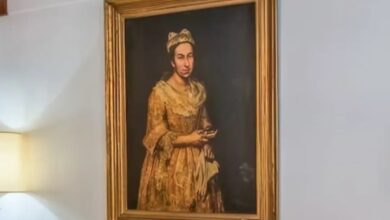“Guernica,” a return that closed the chapter on the Spanish Civil War and exile in 1981
Pablo Picasso's "Guernica," his iconic masterpiece, was unveiled to the public in Spain in 1981, marking a symbolic closure of the chapter defined by the Spanish Civil War and years of exile. Genoveva Tusell, a 6-year-old at the time, closely witnessed the intricate process of negotiating the mural's return from the Museum of Modern Art (MoMA) in New York, a story she has now recounted in the documentary "Guernica: The Last Exile," directed by Guillermo Logar.

Photo: Pablo Picasso
José Luis Picón (EFE)
Escucha este artículo
Leer en español: “Guernica”, un regreso que cerró el capítulo sobre la Guerra Civil española y el exilio en 1981
"Guernica's Homecoming
On October 25, 1981, the day Pablo Picasso turned 100, his iconic masterpiece "Guernica" was publicly displayed in Spain for the first time, symbolically closing the circle of the Spanish Civil War and exile. The complex process of negotiating the return of the mural with the Museum of Modern Art (MoMA) in New York was witnessed closely by a 6-year-old girl, Genoveva Tusell, whose father, Javier Tusell, was the Director-General of Fine Arts in Spain at the time, as recounted in the documentary "Guernica: The Last Exile," directed by Guillermo Logar.
"With six years, you don't understand much. My father constantly traveled to New York and seemed very busy, and I kept hearing about 'Guernica.' I eventually decided it was a painting my father had created," Genoveva Tusell explained. Years later, she became an art historian and, in 2017, published the book "El 'Guernica' Recobrado," born out of a need to pay tribute to her father and recover this history. The archives contain "all the negotiation letters with MoMA, the family, and the documentation proving Spanish ownership of the painting," she points out.
Also read: Through the Chrysalis: Unveiling the Harmonious Intersection of Art and Science
Picasso's Guided Destiny
Tusell emphasizes that the recovery of "Guernica" ran parallel to Spain's political transition process and was the only work by the Malaga-born artist for which he "wrote its destiny." "Picasso, aware that it was his masterpiece, left a document stating it should return to Spain when the Republic was restored. Later, on his lawyer's advice, he altered it to say it should return when democratic freedoms were restored," she underlines. However, in 1981, Spain "needed to demonstrate it had a stable and lasting democracy." As the negotiations reached their final stages, the attempted coup on February 23 occurred. "Nonetheless, Spain's response to the coup became a way to show that democracy was solid, and by September, the painting was here," she highlights.
Regarding the importance of the archives, director Guillermo Logar explains that his initial aim with the documentary was to "highlight how archives function in these investigations and how they have been crucial in contemporary history to resolve significant episodes like the return of 'Guernica.'" According to Logar, he used Genoveva Tusell's book as the "backbone" of the documentary, which recounts what could have been "a fierce battle if MoMA had refused to return it."
Symbol of Sovereignty and Democracy
"Beyond the painting's tremendous symbolism, to deny its return to Spain would have been almost an attack on the country's sovereignty when it was demonstrating there was a more or less reliable democratic system," he affirms. Eventually, "Guernica" returned and, as it was transported by truck from the airport, it was "escorted by the police, as if it were a head of state, a beautiful symbol," Tusell notes. She believes it "closed a chapter in cultural terms because many artists forced to leave Spain after the Civil War never returned, including Picasso himself. 'Guernica' is the visible image of the Civil War, exile, and dictatorship."




